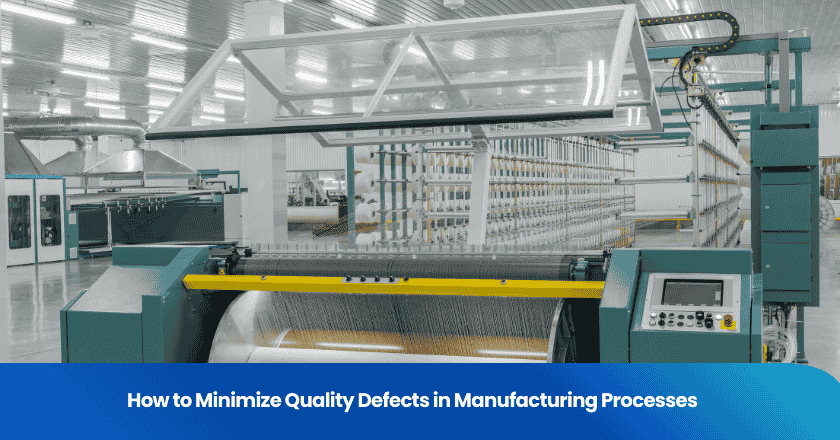
Every year, manufacturers lose billions due to quality defects. You can minimize these losses by focusing on defect prevention and continuous improvement. Early detection of quality issues helps you avoid costly mistakes later. Quality starts with design for manufacturability and continues with standardized processes. When you invest in defect prevention, you protect your reputation and increase customer satisfaction. Quality depends on your commitment to training, clear documentation, and consistent inspection. Quality improvements require you to act before problems happen. Quality drives productivity, profit, and trust. Quality should guide every decision you make.
Key Takeaways
- Prevent defects by designing products for easy manufacturing and involving teams early.
- Standardize work steps and train employees regularly to keep quality consistent.
- Use preventive maintenance to keep machines running well and avoid errors.
- Apply mistake-proofing tools and test products often to catch problems early.
- Use root cause analysis, Lean, Six Sigma, and digital tools to improve quality continuously.
Quality Defects and Their Impact
Types of Quality Defects
You encounter several types of quality defects in manufacturing. These issues can appear at any stage of production. Some common product defects include:
- Material defects: You may find issues with raw materials, such as impurities or incorrect specifications.
- Process defects: These occur when machines or workers do not follow the correct procedures, leading to inconsistent results.
- Design defects: Sometimes, the product design itself causes recurring issues during manufacturing.
- Assembly defects: You might see problems when parts do not fit together as intended.
Tip: Early inspection helps you catch quality defects before they reach your customers. Regular inspection at each stage reduces the risk of defective products leaving your facility.
Business Consequences
Quality defects have a direct impact on your business. When you allow product defects to go unchecked, you risk costly recalls and damage to your reputation. Recalls often lead to lost sales, extra shipping costs, and wasted materials. You also face legal issues if defective products cause harm.
Here is a quick overview of the consequences you may face:
| Consequence | Impact on Business |
|---|---|
| Recalls | Increased costs, lost trust |
| Product recalls | Disrupted supply chain |
| Customer complaints | Lower satisfaction, lost loyalty |
| Legal issues | Fines, lawsuits |
| Production delays | Missed deadlines, higher costs |
You need to address quality issues quickly. If you ignore these issues, you may see a rise in product recalls and more defective products in the market. Frequent recalls signal deeper quality issues in your process. You should treat every recall as a warning sign. Continuous improvement and thorough inspection help you reduce the risk of future recalls. By focusing on quality, you protect your business from the negative effects of product defects and recurring issues.
Foundations for High Production Quality
Design for Manufacturability
You set the stage for strong production quality when you focus on design for manufacturability. This approach means you create products that are easy to build, assemble, and inspect. You reduce the risk of defects by involving engineers, operators, and quality teams early in the manufacturing process. Proof of Principle (POP) studies help you test new designs before full-scale production. You identify potential issues and address them before they impact production quality. Early testing and collaboration between teams ensure that your manufacturing process supports consistent quality.
Tip: Use cross-functional teams to review new designs. This helps you catch problems early and improve production quality from the start.
Standardization and Documentation
You improve production quality by standardizing work procedures. Clear documentation gives every worker a reference for best practices. You reduce variation and errors when everyone follows the same steps. Standard operating procedures (SOPs) form the backbone of your production quality system. You should update these documents regularly to reflect changes in your manufacturing process. Consistent documentation supports quality processes and helps you train new employees quickly.
- Create detailed SOPs for each step in the manufacturing process.
- Use checklists to verify that workers follow quality processes.
- Review and update documentation as your production quality system evolves.
Employee Training
You cannot achieve high production quality without skilled employees. Training ensures that every worker understands the manufacturing process and quality expectations. You should provide regular training on new equipment, updated procedures, and quality processes. When you invest in your team, you build a culture of quality and accountability. Clear responsibility between teams helps you avoid confusion and maintain strong production quality.
Note: Ongoing training supports your quality assurance goals and strengthens your production quality system.
Reduce the Number of Errors
Reducing the number of errors in your manufacturing process is essential for maintaining high production quality. You need to focus on defect prevention, quality control, and continuous improvement to achieve this goal. By targeting the root causes of errors, you can build a robust system that supports consistent quality and minimizes waste.
Preventive Maintenance
You cannot achieve reliable production quality without preventive maintenance. Machines and equipment require regular inspections and servicing to operate at peak performance. When you schedule maintenance before breakdowns occur, you avoid unexpected downtime and reduce the number of errors caused by faulty equipment.
- Inspect critical machines on a set schedule.
- Replace worn parts before they fail.
- Keep detailed maintenance records for every piece of equipment.
Tip: Preventive maintenance supports defect prevention and helps you catch issues before they disrupt your manufacturing process.
You should train your team to recognize early warning signs of equipment problems. This proactive approach ensures that your production runs smoothly and that quality checks remain effective. When you prioritize preventive maintenance, you protect your investment and maintain high production quality.
Mistake-Proofing (Poka-Yoke)
Mistake-proofing, also known as Poka-Yoke, is a powerful strategy for eliminating errors at the source. You design your processes and tools to make it impossible—or at least very difficult—for workers to make mistakes. This approach leads to significant defect reduction and supports your overall quality control efforts.
Common mistake-proofing techniques include:
- Using jigs or fixtures that only allow correct assembly.
- Installing sensors that detect missing or misaligned parts.
- Adding visual cues or alarms to alert workers to potential errors.
| Mistake-Proofing Method | How It Helps Production Quality |
|---|---|
| Jigs and Fixtures | Ensures correct part placement |
| Sensors | Detects errors in real time |
| Visual Cues | Guides workers to follow procedures |
By integrating mistake-proofing into your manufacturing process, you reduce the number of errors and improve production quality. You also make quality checks more efficient, as fewer errors reach the final inspection stage.
Early and Ongoing Testing
Early and ongoing testing forms the backbone of effective quality control. You need to identify defects as soon as possible to minimize waste and prevent faulty products from moving further down the line. Regular inspections and quality checks at each stage of production help you catch errors before they become costly problems.
- Conduct quality checks after each major production step.
- Use statistical sampling to monitor high-risk processes.
- Document all inspection results for future analysis.
Note: Early detection of errors allows you to address issues quickly and maintain consistent production quality.
You should prioritize high-risk areas for frequent inspection. This targeted approach ensures that your resources focus on the most critical points in your manufacturing process. When you combine early testing with ongoing quality checks, you create a culture of continuous improvement and defect prevention.
By implementing preventive maintenance, mistake-proofing, and early testing, you build a strong foundation for production quality. These strategies help you reduce the number of errors, support effective quality control, and drive long-term success in your manufacturing process.
Tools to Improve Production Quality
Root Cause Analysis
You need to identify the real causes of the problem before you can achieve lasting quality improvement. Root cause analysis helps you uncover the root causes of errors that lead to defects and recalls. You can use proven methods such as FMECA, 8D, and Ishikawa diagrams to break down complex issues. These tools guide you through a structured process to analyze failures and prevent them from recurring. When you focus on root cause analysis, you strengthen your quality management system and support continuous improvement operations.
Tip: Document every step of your root cause analysis. This record helps you track quality improvement and share lessons with your team.
Lean and Six Sigma
You can boost production quality by adopting Lean management and Six Sigma practices. Lean helps you eliminate waste and streamline your workflow. Six Sigma gives you tools to reduce variation and improve quality control. Both approaches rely on data-driven decision-making and empower you to set clear goals for quality improvement. You should encourage your team to use Kaizen for small, ongoing changes. These continuous improvement operations drive better results and help you maintain high standards in your quality management.
| Approach | Benefit for Production Quality |
|---|---|
| Lean | Cuts waste, improves efficiency |
| Six Sigma | Reduces errors, boosts quality |
| Kaizen | Supports ongoing improvement |
Digital Solutions
You can enhance production quality by using digital solutions. Modern quality management systems offer real-time monitoring and automated alerts. These tools help you catch defects early and respond quickly. You can analyze data to spot trends and address issues before they affect quality. Digital solutions also make it easier to track corrective actions and measure the impact of quality improvement efforts. When you integrate digital tools into your quality control process, you create a more agile and responsive production environment.
Note: Digital solutions support continuous improvement and help you maintain strong production quality over time.
You drive quality improvement by focusing on prevention. You build quality into every process step. You train your team to recognize quality risks. You document quality standards and update them often. You use quality tools to find root causes. You apply quality checks early and often. You maintain equipment to support quality output. You standardize work to reduce quality variation. You encourage quality feedback from every employee. You commit to continuous quality improvement. Start today by choosing one new quality method to implement.
FAQ
What is the most effective way to improve quality in manufacturing?
You achieve better quality by focusing on prevention. Use early testing, standardized procedures, and employee training. These steps help you catch issues before they affect production. Consistent improvement keeps your quality high.
How does employee training impact quality?
Employee training gives your team the skills to maintain quality standards. You reduce errors and improve consistency. Well-trained workers understand how to spot problems and follow procedures that protect quality.
Why is preventive maintenance important for quality?
Preventive maintenance keeps equipment running smoothly. You avoid breakdowns that can cause defects. Regular checks help you maintain quality by ensuring machines produce consistent results.
How do digital solutions support quality improvement?
Digital solutions provide real-time data and alerts. You monitor production and respond quickly to issues. Automated systems help you track quality trends and take corrective action before defects spread.
What role does root cause analysis play in quality management?
Root cause analysis helps you find the source of defects. You solve problems at their origin, preventing future issues. This approach strengthens your quality system and supports continuous improvement.
Grow your business with TradeAider Service
Click the button below to directly enter the TradeAider Service System. The simple steps from booking and payment to receiving reports are easy to operate.



